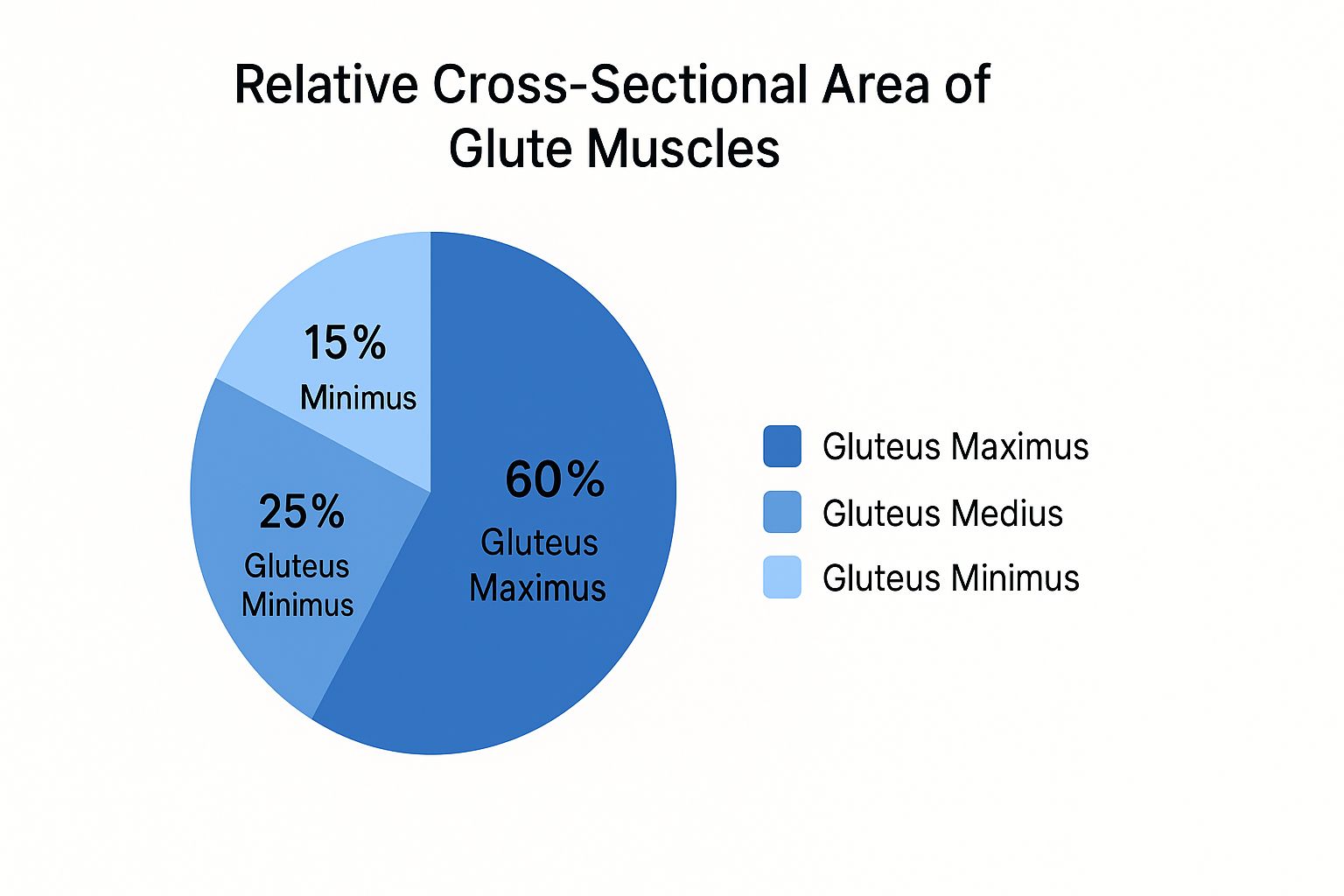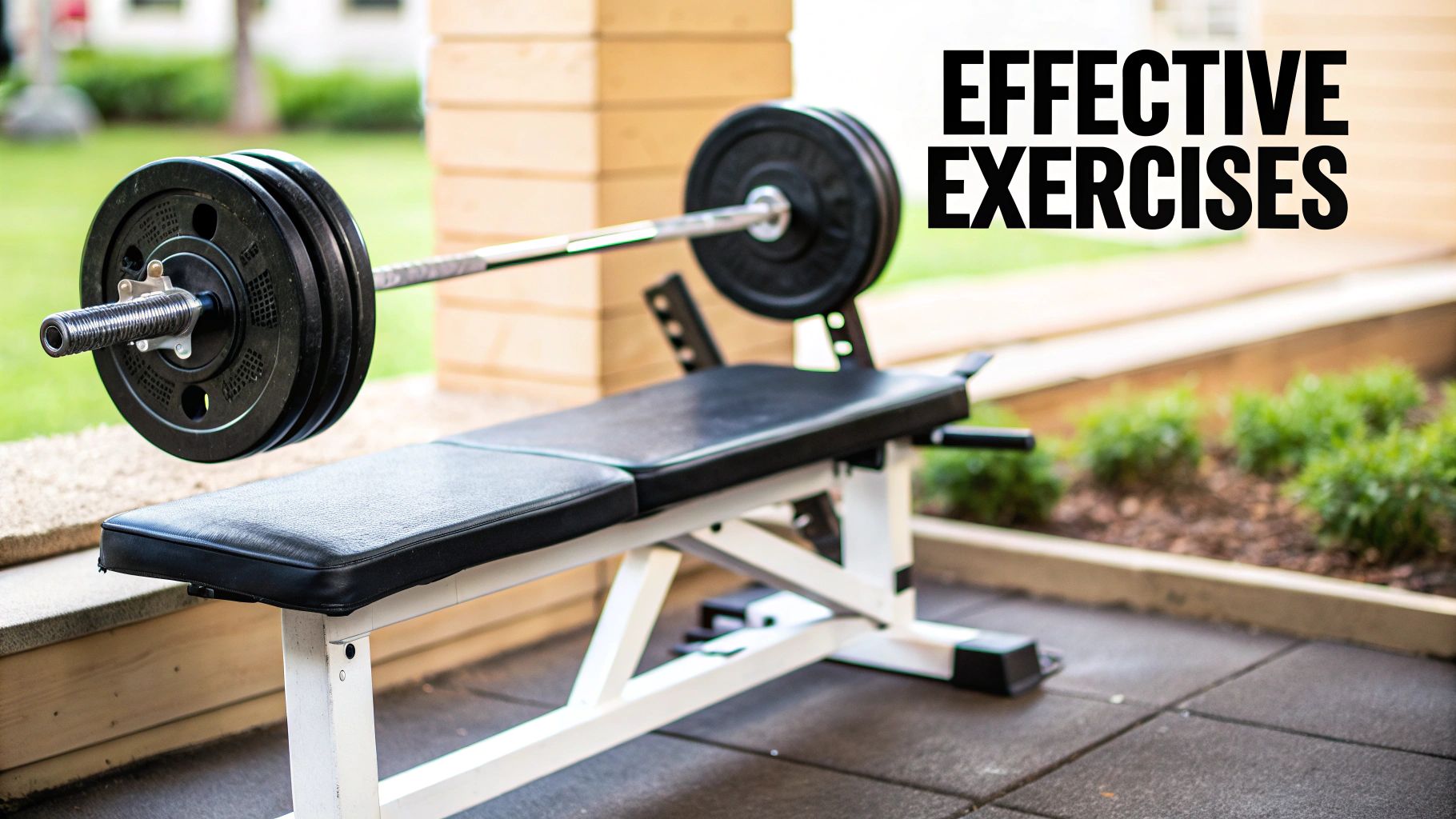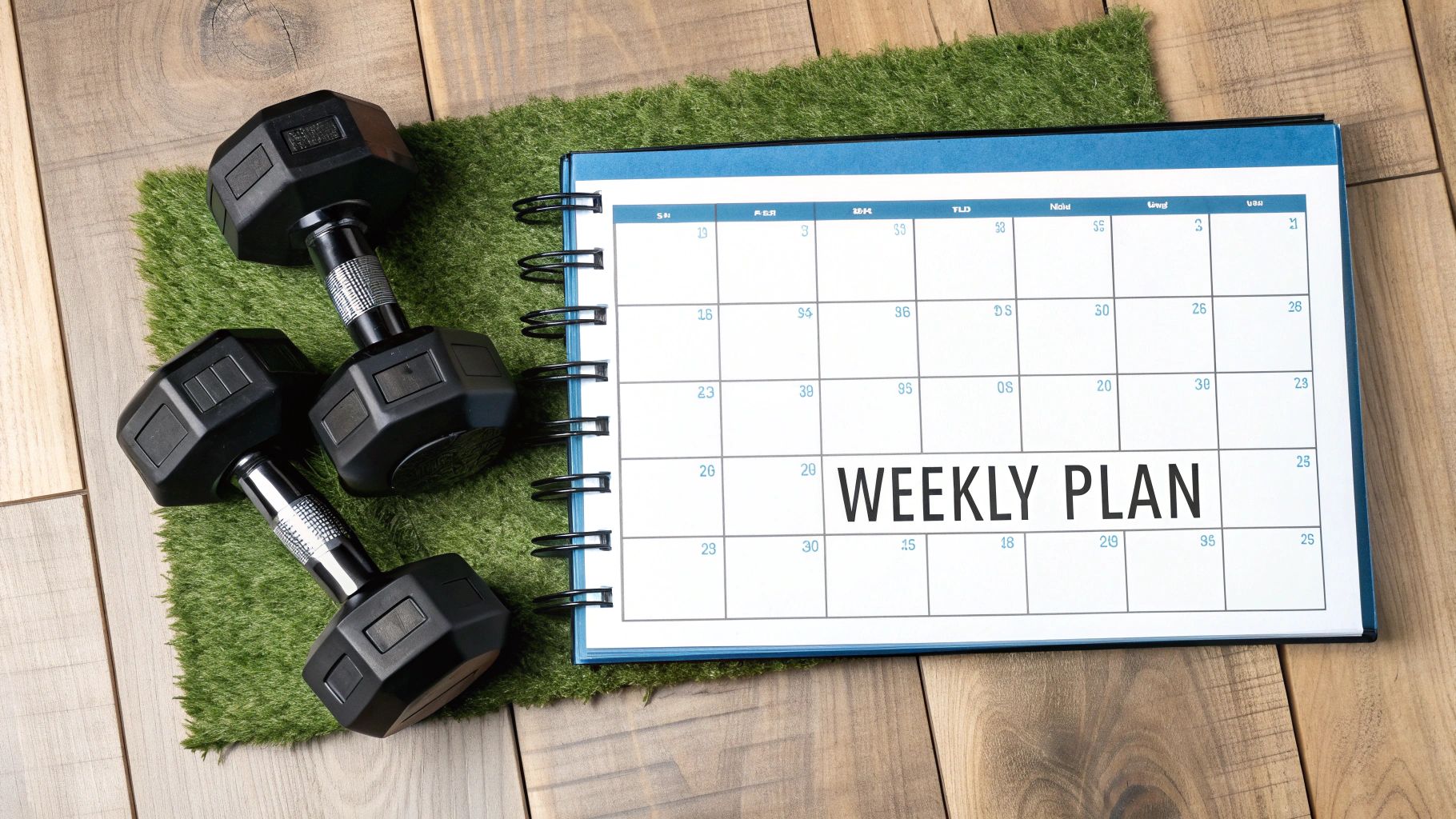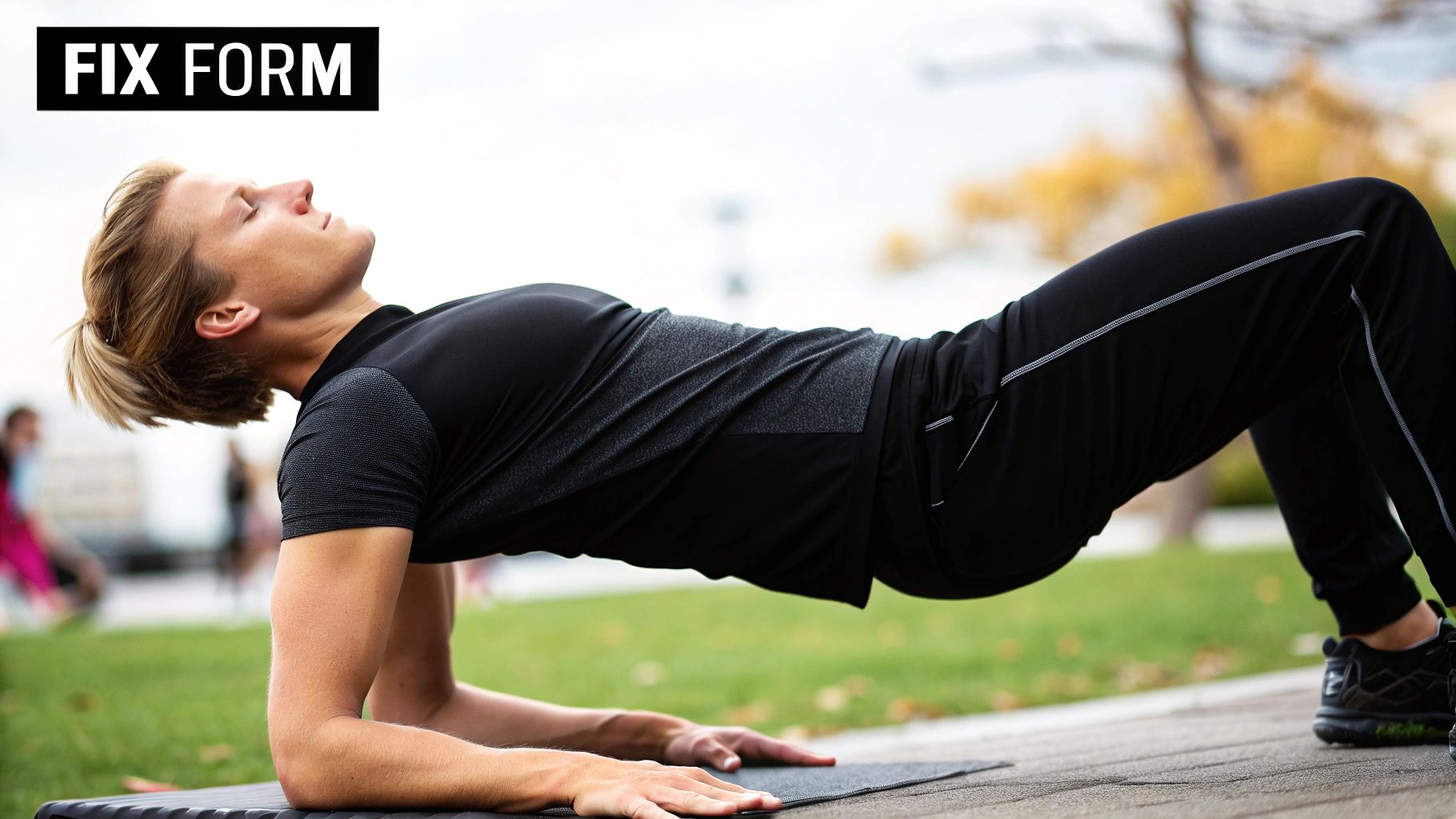
A Practical Guide on How to Build Glutes
Share
If you want to build your glutes, you need two things: targeted exercises that hit all three glute muscles, and a non-negotiable commitment to progressive overload.
That’s it. It's a formula of smart training and solid nutrition that forces your muscles to adapt and grow. And no, it's not about doing endless squats.
Understanding The Foundations Of Glute Growth
Before we jump into the workouts, you need to know what you're working with. Building a strong, well-rounded booty isn't guesswork; it's about hitting the right muscles with the right stimulus.
Most people think squats and lunges are the answer, but this usually leads to overdeveloped quads and glutes that just won't grow. You need a smarter approach.
Your glutes are a powerful system made up of three distinct muscles, and each one has a specific job:
- Gluteus Maximus: This is the big one. It's the largest and most powerful of the three, giving you that full, rounded shape. It powers all your hip extension movements—think hip thrusts and deadlifts.
- Gluteus Medius: Located on the upper and outer part of your hip, this muscle is the secret to creating that "shelf" look. It stabilizes your pelvis and handles hip abduction (moving your leg out to the side).
- Gluteus Minimus: The smallest and deepest of the three, it works with the medius to keep your hips stable and assist with those side movements.
This chart shows you just how much real estate the gluteus maximus takes up. It's why it gets so much attention.

But here's the mistake most people make: they only focus on the maximus. If you ignore the medius and minimus, you'll never get that balanced, sculpted look you’re after.
The Cornerstone Of All Muscle Growth
Knowing the anatomy is one thing, but the engine that actually drives muscle growth is a principle called progressive overload.
If you take away one thing from this guide, let it be this. It is non-negotiable.
Simply put, progressive overload means you have to keep making your workouts harder over time. Your body is smart—it adapts to stress. To keep growing, you have to consistently give it a new reason to.
This doesn't always mean piling more plates on the bar. You can challenge your muscles in a few key ways:
- More Reps: Doing more repetitions with the same weight.
- More Weight: Lifting a heavier load for the same number of reps.
- More Sets: Adding another set to your exercise.
- Better Form: Improving your mind-muscle connection to make every rep count.
Without this constant challenge, your progress will hit a wall. It’s the foundation for everything we’re about to cover. Our guide on how to build lean muscle for women goes even deeper on this.
The Most Effective Exercises for Building Glutes

Alright, this is where the real work begins. Knowing the anatomy is step one, but now we need to put that knowledge into action in the gym. Building glutes isn't about doing a million squats and calling it a day. It's about being strategic.
The fastest way to build round, full glutes is with a smart mix of heavy compound lifts and targeted isolation work. Think of it this way: the heavy stuff builds the foundation and overall size, while the lighter, focused moves carve out the shape and details.
The Heavy Hitters: Compound Lifts
These are your bread and butter. Compound exercises are the foundation for building serious mass and strength. They should be the anchor of your glute days, always done with challenging weight and flawless form.
- Barbell Hip Thrusts: If there’s one king of glute exercises, this is it. Nothing else lets you load the gluteus maximus with this much direct tension, especially at the top of the movement where you get that powerful squeeze.
- Romanian Deadlifts (RDLs): An incredible hamstring builder, yes, but RDLs also put a massive stretch on your glutes. The secret is to hinge at your hips, keep your back flat, and think about pushing your butt back toward the wall behind you.
- Squats & Lunges: Classics for a reason. While they hit your quads hard, variations like deep squats and walking lunges force the glutes to fire. Focus on driving up through your heels to really engage your backside.
Pro Tip: On moves like hip thrusts and squats, try pausing for a full second at the very top of the rep. Squeeze everything. This brief hold skyrockets muscle activation and builds a much stronger mind-muscle connection.
Now, while those are the big three, don't get stuck in a rut. It turns out some other exercises might be even better. A 2020 systematic review actually found that step-up variations generated the highest gluteus maximus activation—even more than squats or deadlifts.
You can dive into the full research on glute activation exercises yourself, but the takeaway is clear: variety is key. This doesn’t mean you should ditch hip thrusts. It just proves that a well-rounded program beats doing the same three lifts over and over again.
Targeted Accessory Work for Shaping
After you’ve hit the big lifts and fatigued your glutes, it’s time to sculpt. This is where isolation or "accessory" work comes in. These moves are done with lighter weight for higher reps to zero in on specific parts of the glutes, especially the medius and minimus, which build that coveted "upper shelf."
- Cable Kickbacks: This is your go-to for isolating the gluteus maximus. The trick is to keep it slow and controlled. Don't just swing your leg—squeeze your glute to move the weight.
- Hip Abduction Machine: The best tool for hitting the gluteus medius. To really make it count, control the negative. Don't let the weights slam back together; resist them on the way in to maximize the burn.
- Glute Bridges: Perfect for warming up the glutes or burning them out as a finisher. You can do them with just your bodyweight for high reps or add a dumbbell across your lap for more of a challenge.
A great program uses both compound and isolation exercises. The combination is what builds both size and a balanced, aesthetic shape.
To help you piece it all together, here’s a quick breakdown of which exercises hit which parts of your glutes. Use this to make sure your workouts are targeting everything.
Glute Exercise Activation Focus
This table shows you the primary target for each movement so you can build a routine that hits all three gluteal muscles effectively.
| Exercise | Primary Target | Secondary Muscles Worked | Best For |
|---|---|---|---|
| Barbell Hip Thrust | Gluteus Maximus | Hamstrings, Adductors | Building overall mass and strength |
| Romanian Deadlift | Gluteus Maximus, Hamstrings | Lower Back, Core | Lengthening glutes under tension |
| Cable Kickback | Gluteus Maximus | Hamstrings | Isolating and shaping the maximus |
| Hip Abduction | Gluteus Medius, Minimus | Tensor Fasciae Latae (TFL) | Building the "upper shelf" look |
By choosing exercises from each category, you ensure no part of the muscle is left behind, leading to faster, more balanced growth.
How to Structure Your Weekly Glute Workouts

Knowing the right exercises is one thing, but that’s just the first step. The real magic happens when you organize those exercises into a smart, consistent weekly plan. Without a solid structure, you’re just guessing—and that can lead to undertraining, overtraining, or just feeling stuck.
The key is finding that perfect balance between pushing your muscles hard enough to grow and giving them enough time to actually recover and rebuild.
For most people focused on building their glutes, that sweet spot is hitting them directly two to three times per week. This gives your muscles the signal to grow (hypertrophy) without burning them out.
Don't just take my word for it. A recent meta-analysis confirmed that training a muscle group anywhere from one to three times a week can trigger significant growth, as long as the intensity is there. It's the consistency that matters most. You can read the full research about glute hypertrophy if you want to geek out on the science.
Designing Your Weekly Split
Okay, so how do you fit this into your real life? You need a schedule you can actually stick with. Here are a couple of incredibly effective ways I’ve seen work time and time again:
- The Focused Split (2 Glute Days): This is my go-to recommendation if you want to dedicate entire gym sessions to your lower body. You'll have one heavy, strength-focused glute day and another lighter, higher-rep day later in the week.
- The Full-Body Integration (3 Glute Days): If you're short on time, this is a lifesaver. You’ll weave a few key glute exercises into three separate full-body workouts. It keeps the frequency high without needing long sessions.
If you're just getting your feet wet in the gym, our beginner gym workout plan is a fantastic starting point for structuring your entire week.
Let’s map out what this could look like.
Example Week: The Focused Split
- Monday: Glute Day 1 (Heavy Stuff: Hip Thrusts, RDLs)
- Tuesday: Upper Body & Core
- Wednesday: Active Recovery (Think a long walk or some stretching)
- Thursday: Glute Day 2 (Lighter Moves: Kickbacks, Abductions)
- Friday: Upper Body & Abs
- Saturday & Sunday: Rest
Notice how this split gives your glutes 48-72 hours of recovery between workouts. That rest period is non-negotiable—it's when the actual growth happens.
Sets, Reps, and Progressive Overload
Once you have your schedule, you need to know what to do in those workouts. For building visible muscle, the 8-15 rep range is your money zone. It’s the perfect mix of heavy-enough lifting and muscle-burning stress that your glutes need to grow.
In each glute-focused workout, you should aim to get in 10-20 hard working sets. What’s a "hard set"? It’s a set where those last one or two reps are a genuine struggle. You should be fighting to finish with good form, but you get it done.
If you want to build your glutes, you have to get comfortable with progressive overload. Lifting the same weight for the same reps every single week gives your body zero reason to change.
Here’s how you put it into practice week after week:
- Track Everything: Get a notebook or use an app. Write down the exercise, weight, sets, and reps for every workout. No guessing.
- Beat Your Last Workout: Next week, your goal is to do just a little bit better. That might mean adding 5 lbs to your hip thrust, pushing for one more rep on each set, or adding another set entirely.
- Form Is Everything: Never, ever sacrifice good form to lift heavier. Progress only counts if it's safe and actually hitting the right muscles.
Fueling Your Body for Serious Muscle Growth
You can do all the hip thrusts and squats in the world, but your glutes won’t grow without the right fuel. The truth is, building a rounder, stronger booty happens just as much in the kitchen as it does in the gym.
Without the right nutrition, your muscles simply don't have the raw materials to repair themselves and grow back stronger after you've worked them hard.
Think of it this way: your workouts are the construction crew, but food provides the bricks and mortar.
The Blueprint for Building, Not Just Burning
To actually build new muscle tissue, your body needs to be in a slight caloric surplus. This just means eating a little more than you burn each day.
We’re not talking about a massive free-for-all. A small surplus of 250-500 calories over your daily maintenance is the sweet spot. This gives your body enough extra energy to build muscle without packing on unwanted fat.
Your diet needs to be built on three key players:
- Protein: This one is non-negotiable. It’s the literal building block for muscle repair.
- Carbohydrates: Think of these as your premium fuel. They power you through those tough training sessions.
- Fats: Healthy fats are essential for regulating hormones—including the ones critical for muscle growth.
Get these three right, and you're giving your body everything it needs to perform, recover, and finally grow.
A huge mistake women make is trying to build glutes while in a steep calorie deficit. Your body is smart—if it thinks it's starving, it will prioritize survival, not building new muscle.
Your Daily Fuel Checklist
So what does this actually look like on your plate? Don't worry, it doesn't have to be complicated.
For protein, aim for 1.6-2.2 grams per kilogram of your body weight. If you weigh 150 pounds, that’s about 109-150 grams of protein a day. This ensures you have a constant stream of amino acids ready to repair the muscle fibers you broke down at the gym.
Great sources include things like:
- Lean meats (chicken breast, turkey)
- Fish (salmon is fantastic)
- Eggs and Greek yogurt
- Plant-based options like tofu, lentils, or a quality protein powder
Carbs are just as crucial. They restock your muscle glycogen—the energy source your muscles run on. Skimp on carbs, and your workouts will feel sluggish and weak. Try to eat a good portion of them after your workout to kickstart the recovery process.
Finally, adding a proven supplement can give you a serious edge. Creatine, for example, is one of the most studied supplements on the planet for improving strength and muscle growth. It helps your muscles generate energy during heavy lifts, allowing you to push for that extra rep that really stimulates growth.
If you want to dive deeper, you can check out this guide on the best creatine for glute growth and see how it fits into a solid nutrition plan.
Common Glute Training Mistakes and How to Fix Them

Even when you have the perfect workout plan, a few small, sneaky mistakes can bring your progress to a grinding halt. If you feel like you’re putting in the work but your glutes still look the same, it’s time to play detective with your technique. A few simple tweaks are often all it takes to get things moving again.
One of the biggest culprits? Ego lifting. It feels incredible to load up the bar, but if your form falls apart, you’re just training your lower back and your pride—not your glutes. This is a classic trap in exercises like hip thrusts and deadlifts.
Remember, the goal isn't just to move weight from A to B. It's to make your glutes do all the work.
Neglecting Your Mind-Muscle Connection
Ever finish a set of hip thrusts and feel it more in your lower back or hamstrings than your butt? That’s a tell-tale sign of a weak mind-muscle connection. You’re just going through the motions instead of consciously telling your glutes to fire.
The fix is simple: slow down. On every single rep. At the top of a hip thrust, pause for a full second and squeeze your glutes like you’re trying to crack a walnut between them. This tiny change forces the right muscles to engage and is non-negotiable for anyone serious about building glutes.
Common slip-ups like arching your lower back, overextending your hips, or letting your core go slack will kill your results and put you on the fast track to injury. To learn more about nailing your form, check out these glute challenge insights from Women's Health.
Program Hopping and Impatience
We live in a world of instant everything, so it’s easy to get discouraged and jump to a new workout every few weeks. This is a massive mistake called program hopping, and it’s one of the fastest ways to guarantee you won't see results.
True muscle growth is a slow-cooker process, not a microwave meal. If you switch your routine too often, you never give your body a chance to adapt and grow stronger.
You need to stick with a solid program for at least 8-12 weeks before you even think about changing it. This consistency is what allows you to progressively overload your muscles by adding weight or reps over time—and that’s the real secret to growth.
Here are a few other common errors I see all the time:
- Rushing Your Reps: You’re using momentum, not muscle. You need to control the entire movement—both the way up (concentric) and the way down (eccentric).
- Poor Exercise Selection: Doing endless squats and lunges is not enough. Your routine needs direct glute work like hip abductions, glute kickbacks, and hip thrusts.
- Not Resting Enough: Your glutes don’t grow in the gym; they grow while you recover. Prioritize sleep and don’t skip your rest days.
By auditing your training for these common pitfalls, you can make sure every ounce of effort you put in actually goes toward building the glutes you want.
Your Glute Building Questions Answered
Even with a perfect plan, you're going to have questions. Let's get into the big ones that always come up, so you can stop second-guessing and just focus on your training.
How Long Does It Realistically Take to Build Noticeable Glutes?
This is the one everyone asks, and I'll be straight with you: it takes patience. You’ll probably feel stronger and notice your glutes firing better within a few weeks, but real, visible growth usually takes at least 2-3 months of consistent training and solid nutrition.
Those head-turning, "wow" transformations? That's the result of 6-12 months (or more) of serious dedication. Things like your starting point and genetics definitely play a part, but consistency is the one thing you have total control over.
Can I Build Glutes at Home with Minimal Equipment?
Absolutely. The gym has more heavy-lifting toys, but you can 100% build your glutes at home. The game is the same: find ways to make your exercises harder over time.
- Bodyweight Basics: Get really good at high-rep glute bridges, frog pumps, and single-leg exercises. Don't underestimate them.
- Get Some Bands: A good set of resistance bands is non-negotiable for home workouts. They’re perfect for adding tension to moves like clamshells and lateral walks that hit the glute medius—a muscle crucial for that rounded shape.
- Add Some Weight: Once bodyweight feels too easy, grabbing a few dumbbells or kettlebells for your lunges and hip thrusts is how you’ll keep the growth coming.
Progressive overload at home just looks a little different. It might mean adding more reps, grabbing a stronger band, or cutting your rest time. The principle is exactly the same—challenge the muscle.
Do I Need to Lift Heavy to Grow My Glutes?
Lifting heavy is an amazing tool for building dense, strong glutes, but it’s not the only tool. Muscle growth happens across a huge range of reps and weights.
The smartest approach mixes heavy and lighter training. You could start your workout with heavy hip thrusts in a lower rep range, like 5-8 reps, to build that foundational strength. Then, you can finish off with higher-rep "pump" work, like cable kickbacks for 15-20 reps, to create that metabolic stress and burn that helps shape and define the muscle. Combining both usually gives you the best of both worlds.
Ready to give your body the fuel it needs to build stronger, fuller glutes? Bold Buns creates clean, science-backed creatine designed specifically for women to enhance strength, performance, and results. Discover the Bold Buns difference today.
